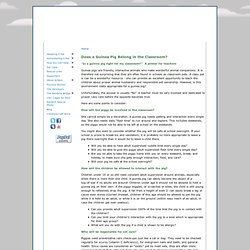

Pets help reduce bullying: Celebrating National Pet Month - Philadelphia School bullying. National Pet Month is celebrated in April and May.

It is honored in May in the United States and April in the United Kingdom. The purpose is to acknowledge the benefits that pets give to people, highlight the work of pet care professionals, companion and therapeutic animals and to help raise funds for pet care charities (nationalpetcare.org.uk). In many schools pets are being used as a technique to help students who have disabilities, behavior issues, reading and bullying problems. Bullying is a serious problem in schools. According to the National Center for Education Statistics, nearly a third of all students between the ages of 12 and 18-years-of-age reported being bullied at school in 2007.
Healing Species is another program that uses animals to reduce aggression and insensitivity in young people. The programs that use pets to help eliminate bullying seem to be working. Can dogs reduce bullying in schools? Burning Question posted on October 3, 2011, at 6:45 AM Dogs have long helped out in the classroom, sometimes with reading programs (pictured) and stress relief: Now, canines are being recruited to help teach compassion and reduce bullying.
Photo: Robin Nelson/ZUMA Press/Corbis SEE ALL 99 PHOTOS From surfing to sniffing out cancer , what can't dogs do? Now, reports that a number of school programs across the country are using dogs to teach kids empathy and compassion in an effort to help curb school bullying. Dogs help schools lick bullies. Sweet-natured dogs lolling about classrooms are helping take a bite out of bullying — and other bad behaviors — in Kansas City schools.

No More Bullies teaches, with dogs' help, responsibility, compassion, self-control and integrity. Since its small launch five years ago, teachers and counselors have become so convinced of the positive impact on kids' behavior that it's booked into the 80-classroom max it can handle, and there's a long waiting list of requests for next year. The curriculum, developed by ex-teacher Jo Dean Hearn, humane education director at animal rescue group Wayside Waifs, is presented an hour a day for five days by trained volunteers — accompanied by irresistible canines. Classroom critters - News. Education Grants. Classroom pets teach the importance of responsibility - The Daily Sentinel: Features.
Mr.

Fuzz Ball has an easy life. He lives in a cage inside Maria Kirkland’s second grade class room at Caldwell Elementary. During the night Mr. Fuzz Ball sleeps, waiting for day when his best friends, all 15 students in the class, return to greet him, bringing warm smiles and friendly hellos as they start another day. At lunch he eagerly awaits left over carrots or lettuce brought to him by the students. Animals Make Good Teachers. Pets. Www.KINDERART.com Printer-Friendly Page Pets in the Classroom Written by: Andrea Mulder-Slater [Andrea is one of the creators of KinderArt.com] Pets are a wonderful source of happiness and inspiration.

Educators have used animals in the classroom for decades. From a goldfish filled aquarium to the hamster who roams the classroom floor in his roller ball, there is no doubt that critters are a great educational tool. An animal in the classroom creates improved learning experiences for your students as all areas of the curriculum are enhanced. If you are thinking of adding a pet to your classroom, please don't feel discouraged. Still interested? Port Angeles School Board to ban classroom pets. PORT ANGELES, Wash. - The Port Angeles School Board is banning classroom pets because of concerns that dogs, rabbits, snakes and baby chicks threaten student health and safety.

The Peninsula Daily News reports the board voted 4-1 in favor of the ban this week and will take a final vote at its June 11 meeting. “Why can’t we have a classroom gerbil?” Asked Sarah Methner, the lone board member who voted against the ban. "It's a nanny state gone wild. " But Lonnie Linn, board vice president and a member of the committee that created the wording for the new rule change, said a classroom gerbil is nothing more than a "varmint.
" Does a Guinea Pig Belong in the Classroom? "Is a guinea pig right for my classroom?

" A primer for teachers Guinea pigs are friendly, interactive animals who make wonderful animal companions. It is therefore not surprising that they are often found in schools as classroom pets. A class pet is can be a wonderful resource - she can provide an excellent opportunity to teach the children about proper animal husbandry and responsible pet ownership. However, is this environment really appropriate for a guinea pig? Unfortunately, the answer is usually “No”. Here are some points to consider: Pass On the Classroom Pet. March 7, 2012 There are better ways to teach students about animals and responsibility The Humane Society of the United States Shevaun Brannigan/The HSUS Well-intentioned teachers often bring pets into the classroom to give their students lessons in respect, responsibility, and empathy for animals.

But from the animal’s perspective, this isn’t always the best option. Busy, noisy classrooms can be stressful, and small animals can be very adept at hiding symptoms of illness or injury (a lifesaving attribute when trying to avoid predators in the wild, but less than ideal in a setting where children are present).
Small animals need large habitats that may not fit in the classroom, and many species need ample fresh produce daily. Even without a live animal present, lessons in responsible pet care and respect for all animals can still be a part of the classroom experience. Invite animal experts into the classroom Members of the community may be willing to speak to your students. Say 'No' to Class 'Pets'